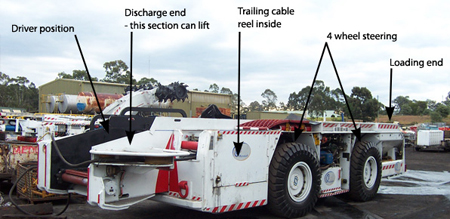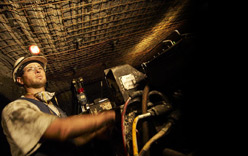Face Area Haulage
With virtually all main coal haulage systems within
the seam being by conveyors which start from a more or less fixed point, some
arrangement is needed to bridge the gap from the coal cutting machine to that
point.
For a longwall face the gap is bridged by the AFC and
BSL, both of which are dealt with under longwall equipment and will not be
discussed here.
For other mining systems, a more flexible arrangement
is required as coal has to be transported from other roadways back to a fixed
point, with frequent changes of the mining location. By far the most common
method of transport at present is the use of "shuttle cars".

Typical shuttle car viewed from discharge end.
Trailing cable connects to closest corner, driver located on opposite side
Shuttle cars are electric powered, rubber tyred
vehicles - essentially a large trough with a scraper conveyor running along the
floor, a driver's position mounted to one side and a jib section at one end of
the conveyor which can be raised for discharging the load. They are four wheel
steered, four wheel driven vehicles with power supplied by a trailing cable
reeled onto and off a cable reeler mounted opposite the driver's position.
It is normal for two cars to be used in one mining
section with one car being loaded by the continuous miner at the face while
the second car is discharging its load at the conveyor. Whilst being loaded,
the scraper conveyor in the shuttle car is run in short bursts to drag the load
towards the opposite end of the car until the car is full. That car then heads out
to the conveyor discharge point, passing the other car at a shunting position
on the way.
On reaching the conveyor, the unloading jib section is
raised to enable coal to be discharged into the "breaker feeder" or directly onto the conveyor (depending on
the mine's relevant equipment and practices) and the scraper conveyor is run
until the car is empty. This car will then return to the mining machine or to
the passing shunt to await the other car.
Shuttle cars have proved to provide a robust, flexible
and generally reliable haulage system and are still very popular. They do
suffer from a number of disadvantages:
-
Trailing cables are prone to damage as a
result of being run over, squashed against the ribs or other equipment or
jammed and pulled apart and can be a safety hazard as well as a common source
of downtime.
-
Trailing cables essentially restrict the
number of cars servicing a miner to two, without a risk of tying the cables in
knots.
-
The haulage is intermittent (unless a car
is used as a temporary bunker behind the continuous miner).
-
The distance between the mining face and
the conveyor discharge point is limited by the length of the trailing cable,
unless other special arrangements are adopted.
Other equipment has been developed to try and overcome
some of these problems:
-
Battery powered shuttle cars were developed
to avoid trailing cables and provide more flexibility; some success and
certainly more flexible, but batteries are bulky and heavy and require time to
charge up and cool before use – this entails a charging station and
battery changing equipment. All of this can be just as troublesome and
hazardous as using cables, so is only beneficial if the extra flexibility is
required.
-
Diesel powered shuttle cars were similarly
developed to avoid the use of trailing cables and provide more flexibility;
certainly more flexible than either cable or battery powered cars and haulers
and are unrestricted in respect to distance between loading and discharge
points. Their biggest drawback is the production of diesel fumes and heat in
the face area which can create unpleasant conditions even with good
ventilation.
-
Another development has been the use of "ram
cars" or "haulers" in place of shuttle cars: these are
articulated vehicles with one end carrying the power system and the driver
position, the other end consisting of a large tray or bin with a push plate to
eject the load. The push plate is operated by a hydraulic cylinder. Ram cars or
haulers are operated similarly to shuttle cars except the cars have to be
turned between the loading and discharge locations, loading and unloading being
at the same end of the vehicle. Ram cars/haulers are usually diesel or battery
powered.Neither of these systems have received wide acceptance to date.
-
Flexible conveyor trains; various types
have been produced including both floor mounted and roof mounted continuous
conveyor systems with both systems offering some degree of operational
flexibility. The discharge end of the flexible conveyor runs above the end
section of the main conveyor to enable the flexible conveyor to discharge onto
the panel conveyor as the flexible conveyor follows the continuous miner
through the development sequence, The face end of the flexible conveyor is
attached to the rear of the continuous miner or is self propelled and kept at
that position. With such an arrangement the flexible conveyor is always in
place between the miner and the main conveyor, providing continuous haulage.
The main disadvantage to date is the high capital cost of such systems and the
high maintenance costs associated with the flexible belting. The flexible
conveyor trains, at this stage, cannot handle right angle bends and necessitate
formation of diamond shaped pillars, which may in some circumstances be prone
to crushing on pillar ends and/or result in larger intersections than otherwise
preferred. Some mines also consider that the angled cut-throughs that result do
not suit most other aspects of mining. Both roof and floor mounted flexible
conveyor systems were trialed in Australian mines during the late 1980's with
limited success. However there is now a resurgence of interest in these systems
as mines seek to improve gate road development rates,
-
Bridge conveyor systems: again various
types have been produced including both chain type conveyors and conventional
conveyor belt systems. Bridge sections are typically short (6m on conveyor
bridges and 16m on chain type bridge systems) and are self propelled (the
conveyor bridge systems are now fitted with PLC controls which enable the
entire system to be operated by one person whereas the chain type require an
operator on each bridge section). Again angled cut-throughs are preferred (70o)
to facilitate transition between adjacent roadways. Depending upon seam (and
hence mining) height the discharge end of these systems can either run over or
beside the main conveyor to enable the bridge conveyor to discharge on the
panel conveyor as the bridge conveyor follows the continuous miner through the
development sequence. Both bridge systems provide a continuous haulage system
similar to the flexible conveyor train systems while both have only recently
been introduced into Australian mines (although a chain type bridge system was
operated in one Australian mine during the 1990's with limited success)
With all the car or hauler arrangements, some fcaility
is needed to load efficiently at the panel conveyor. At least a "boot end" is required, a trough arrangement with a
top opening slightly narrower than the conveyor belt. The return roller for the
conveyor is at the end of the boot nearest the face, so the belt runs under the
opening in the top of the boot to carry the coal away. The coal can be loaded
on top of the boot, the pile reducing at the rate that the belt can remove the
coal. Care is therefore required to ensure that loading is not too fast
otherwise spillage will occur. The belt will be fully loaded whilst there is
coal left in the boot.
A better means of transferring the coal from car to
belt is to use a "breaker feeder". This is a large hopper fitted with a scraper
conveyor in the floor leading to a narrow outlet, approximately the width of
the conveyor belt, and often containing a coal breaker at the outlet. The use
of a feeder enables the car to discharge at maximum rate while the feeder
controls the feed rate onto the belt to the desired rate. This is particularly
important as high shuttle car discharge rates have been proven to result in
higher development rates, whilst controlled feed out rates from the feeder will
prevent overloading of the conveyor and the ensuing spillage. While the breaker
on the feeder may not be as effective as a crusher in reducing product size,
they are generally effective in breaking large lumps of coal or stone into more
manageable sizes and improving conveyor loading.
Flexible conveyor trains and bridge conveyor systems
feed directly onto the panel conveyor and obviate the need for a breaker feeder.
Recent trials with both systems do however highlight the need to introduce a
capability to size any large lumps that may be produced if high productivity
levels are to be sustained. This can be done either by fitting an in-line
breaker into the throat of the continuous miner discharge boom or onto the
first bridge section behind the continuous miner.

